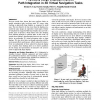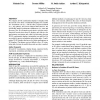297 search results - page 51 / 60 » chi 2004 |
CHI
2004
ACM
15 years 11 months ago
2004
ACM
Facial affect (or emotion) recognition is a central issue for many VMC and naturalistic computing applications. Most computational models assume "categorical perception"...
CHI
2004
ACM
15 years 11 months ago
2004
ACM
Previous results have shown that users perform better on spatial orientation tasks involving static 2D scenes when working on physically large displays as compared to small ones. ...
CHI
2004
ACM
15 years 11 months ago
2004
ACM
We compare 2D/3D combination displays to displays with 2D and 3D views alone. Combination displays we consider are: orientation icon (i.e., side-by-side), in-place methods (e.g., ...
CHI
2004
ACM
15 years 11 months ago
2004
ACM
Level of Web experience is often a factor for which researchers attempt to control while conducting experimental studies on Web usability. It is typically measured by some means o...
CHI
2004
ACM
15 years 11 months ago
2004
ACM
Physical design environments are places that support people engaged in the spatial, physical, tangible act of creation. It is now possible to augment workspaces with an amazing ar...


